Katsuobushi Ambassador: Mai Nagamatsu’s Bonito Flake Story
Mar 16,2023
Katsuobushi Ambassador: Mai Nagamatsu’s Bonito Flake Story
Mar 16,2023


Freshly shaved katsuobushi [flakes of dried bonito] are placed on top of piping-hot white rice and served with miso soup made with first-brewed dashi stock. Serving this breakfast, which stars katsuobushi, is Katsuo Shokudo, a restaurant in Tokyo’s Shibuya area. Queues often form in front of this popular restaurant, once the word got out that it earned a Michelin Bib Gourmand Award for two straight years. The owner is Nagamatsu Mai, a spirited katsuobushi evangelist, who is affectionately known as Katsuo-chan. We spoke with Nagamatsu about her love for katsuobushi, which she says changed her life.
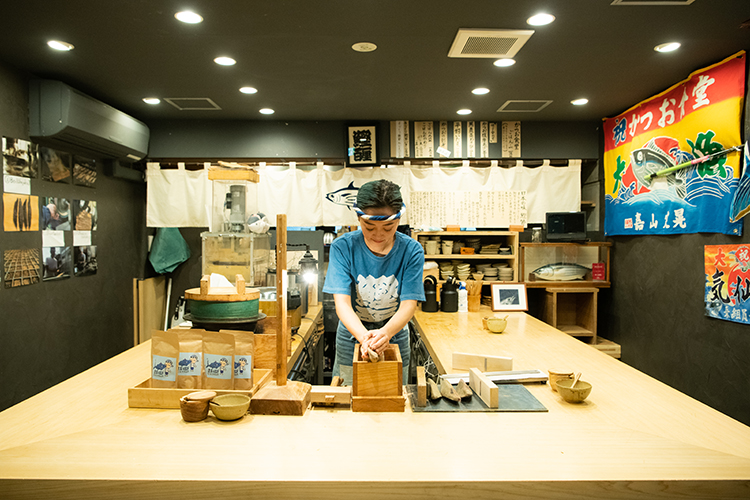
Nagamatsu Mai stands behind Katsuo Shokudo’s counter, shaving katsuobushi with a rhythmical, swooshing sound. Nagamatsu first became fascinated with katsuobushi watching her grandmother shave katsuobushi blocks.
“I didn’t know what I wanted to do at that point in my life, and I was doing nothing but going out every night. But then, while visiting my grandmother’s place in Fukuoka, I found myself closely watching her pose as she shaved katsuobushi. She looked so cool to me, and I wanted to be like her. The miso soup she made me was more delicious than any I had ever had, and I thought katsuobushi is amazing. She told me a story that day about how when she was a girl every home had a special tool called a kezuriki for shaving katsuobushi. It was the first time for me to see someone shave katsuobushi; it felt like being in an old legend.”
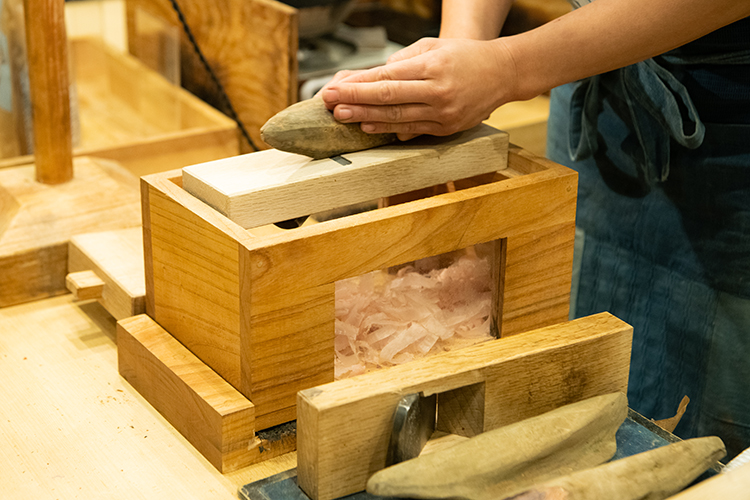
The restaurant has a custom-built kezuriki with plastic sides so you can see the shavings pile up
Nagamatsu got into shaving katsuobushi when she inherited her grandmother’s prized kezuriki. As she began using freshly shaved katsuobushi as toppings on her meals, she became engrossed with how katsuobushi produces flavor and aroma that create a congenial atmosphere. She started wondering one day about the way katsuobushi blocks are made and decided to visit a katsuobushi producer.
“The first producer I visited about 10 years ago was in Tago in the Nishiizu region of Shizuoka. The katsuobushi producer there told me that katsuobushi is a valuable part of Japan’s food culture that needs to be preserved for future generations. He explained that katsuobushi is produced in many regions and that I should search around and find the taste that suits me the best.”
After that formative experience, Nagamatsu spent three and half years visiting various producers, from Miyakojima in the south to Kesennuma in the north. As she witnessed firsthand how each producer makes katsuobushi and the emotions they instill into their products, she found her favorite type to be honkarebushi produced in the traditional way. Honkarebushi is katsuobushi of the highest quality, fermented and matured through multiple cycles of mold applications and sun-drying that takes more than six months of labor to make. Honkarebushi accounts for roughly two to three percent of all katsuobushi production and is rarely found in supermarkets.
“You can study how to make katsuobushi by reading books, but real production sites seldom go by the book. This is true of honkarebushi as well, as each producer uses a different process. It’s about how they breathe life into this bounty of nature and transform it into deliciousness. When you watch how they create the honkarebushi blocks, you realize it’s much like raising a child. If you are too strict with them, the blocks rebel, and if you are too lenient, they become lazy. Some artisans even told me that when they ship out their katsuobushi, it feels like sending a daughter off to be married. It’s because katsuobushi is made with such love that I’m so fond of it.”
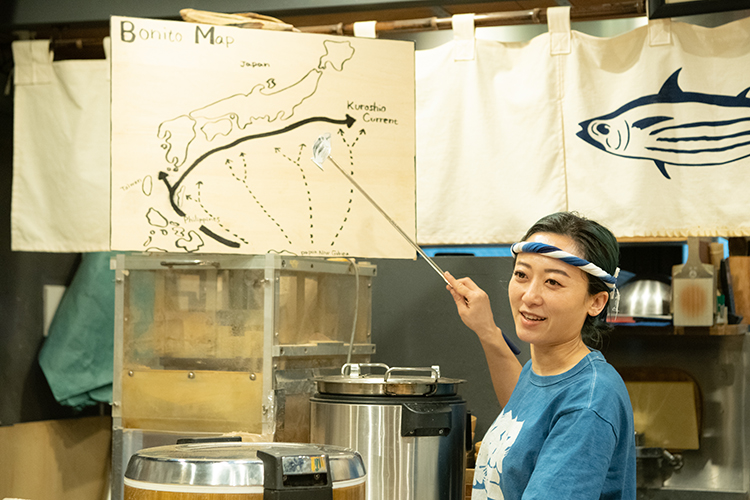
Even during business hours, if you ask a question about katsuobushi, Nagamatsu will give you an impromptu lesson using homemade teaching materials
In order to learn more about bonito, Nagamatsu visits locations where bonito are landed as well as katsuobushi production regions. She will occasionally even take a boat from Miyakojima and go fishing for bonito.
“As you shave katsuobushi, the uniqueness of each block becomes apparent, with some blocks having more fat and some having a more acidic flavor. This uniqueness comes from the fact that the katsuobushi reflects the qualities of the individual bonito. Landed bonito have very different expressions: some look like they fought bravely while others look sorrowful. Fishing for bonito is a world of life or death, and fishers risk their lives. Compared to what they do, shaving katsuobushi and putting the flakes on bowls of rice is trivial. There are so many stories that happen before the katsuobushi reaches your table. At my restaurant, I want to see that this lore is told.”
As she delved into her passion for katsuobushi, Nagamatsu felt a budding sense of responsibility to tell the stories behind katsuobushi. She opened Katsuo Shokudo for this precise reason: to communicate to more people the allure of katsuobushi. She decided to specialize in breakfasts because there were very few places in Tokyo where you could have a relaxing breakfast.
“When I have rice and miso soup in the morning, I feel like I’ve started the day off on the right foot. When I used to visit katsuobushi producers, they would serve me freshly cooked rice topped with a generous helping of katsuobushi and miso soup made by simply pouring hot water over katsuobushi. Those meals were so delicious, and it’s why I decided to keep my menu simple to tell the tale of katsuobushi.”
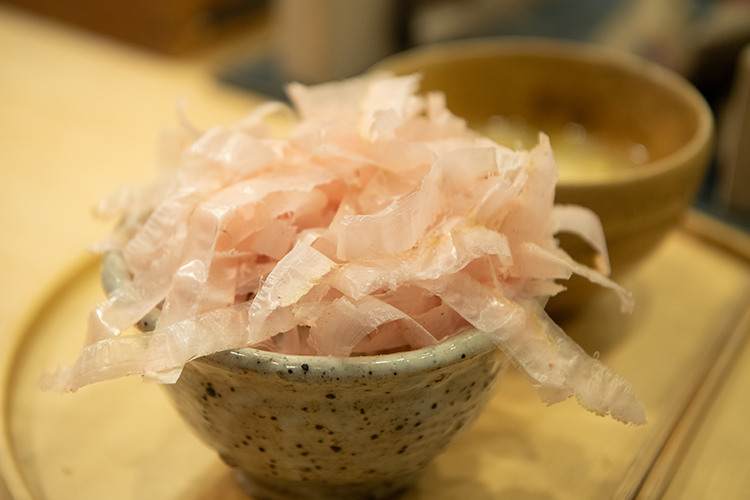
Katsuo Shokudo offers a breakfast special of rice topped with katsuobushi and miso soup
Nagamatsu carefully selects all the ingredients used at Katsuo Shokudo herself. The rice, which is cooked in a traditional, broad-brimmed hagama pot, is produced by Nagano’s Iijima Farm. For the miso soup, Nagamatsu blends miso produced in Oita, which her grandmother once used, with barley miso. The soup’s own flavor is kept mild to better savor the dashi stock.
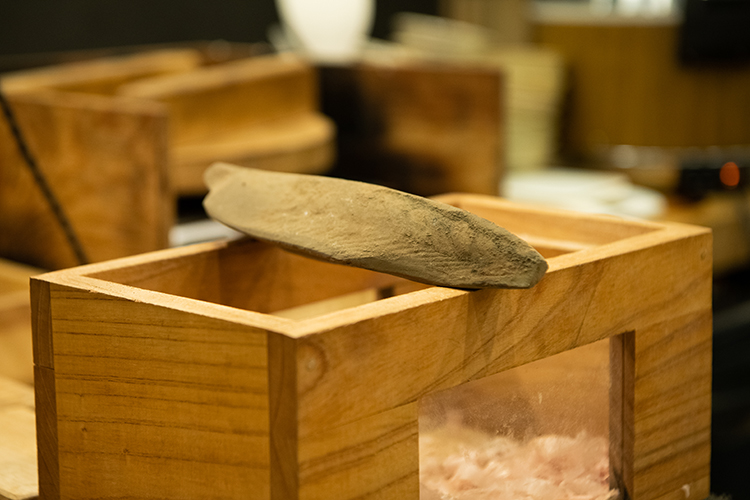
The katsuobushi on the day of our visit was kokorobushi made in Ibusuki, Kagoshima
And it’s no surprise that the restaurant stocks only katsuobushi that Nagamatsu is partial to. Keeping the kezuriki in top shape is another essential part of bringing out the katsuobushi’s full flavor and aroma. She sharpens the blades and makes fine adjustments to the kezuriki every day, and she even switches out blades multiple times while shaving and serving katsuobushi.
“Katsuobushi oxidizes in 30 minutes, which is why freshly shaved katsuobushi is so delicious,” Nagamatsu says. The thin, fluffy fresh shavings feel pleasant on the tongue, as the mellow aroma and gentle umami flavor spread throughout your mouth and satisfy your soul.
To further spread her message of katsuobushi’s benefits and appeal, Nagamatsu published the book The Delicious Life of Hand-Shaving Katsuobushi in February 2023. The book is full of her passion to get more people into shaving katsuobushi.

“It’s true that hand-shaving katsuobushi involves a little bit of strenuous work, but the process has so much to it. As you shave the block, it brings to mind how the katsuobushi came into being and you sense a warmth that reminds you of the precious origins of what food really is.
“Having said that, I recognize for many people it’s intimidating to add hand-shaving to their daily routine, and there’s a strong sense that if you go to such lengths to prepare dashi stock, then you have to make an elaborate meal to go with it. But just sprinkling salt and fresh shavings on natto [fermented soybeans] makes a complete dish, or mixing crunchy, powdery katsuobushi with salt creates a delicious spice-like topping that you can put on deep-fried dishes. I wrote the book to dispel old-fashioned ideas about katsuobushi.”
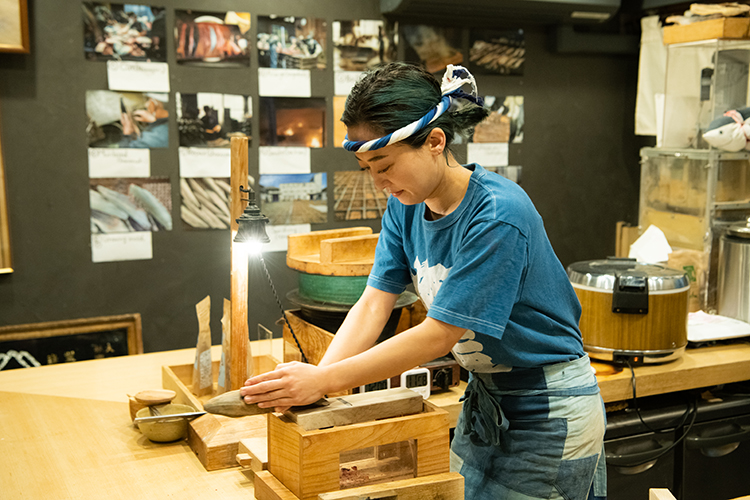
Once you taste the fresh shavings, you’ll want to get your own kezuriki. Nagamatsu is currently developing an easy-to-use kezuriki for home use.
Another mission Nagamatsu has is to train successors to pass on the culture of katsuobushi to future generations. She is currently looking for someone to become the second-generation Katsuo-chan to help her carry Katsuo Shokudo into the future.
“Katsuo Shokudo always pays respect to the fishers and katsuobushi producers. I want to train a second-generation Katsuo-chan in order to maintain this restaurant as a place in Tokyo that communicates the authentic taste, respect, and traditional culture of katsuobushi. Another area I want to focus on is food education for kids, so I can pass the baton on to the next generation. A life of hand-shaving katsuobushi is a life full of Japanese tradition. I want to bring this genuine taste of Japan into people’s lives.”
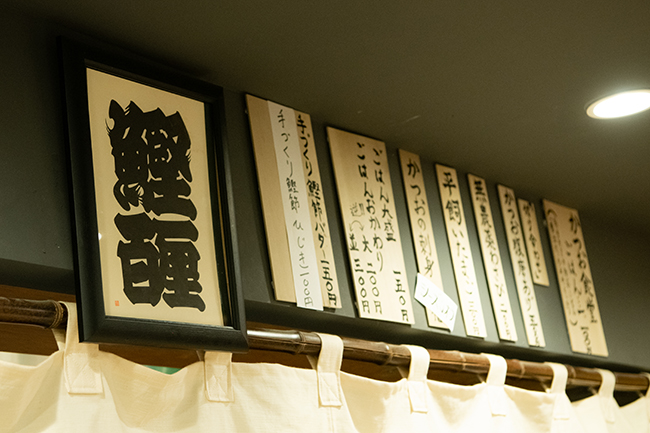
Note that the restaurant operates on an irregular schedule. Check the Instagram page for updates on days when the restaurant is open.